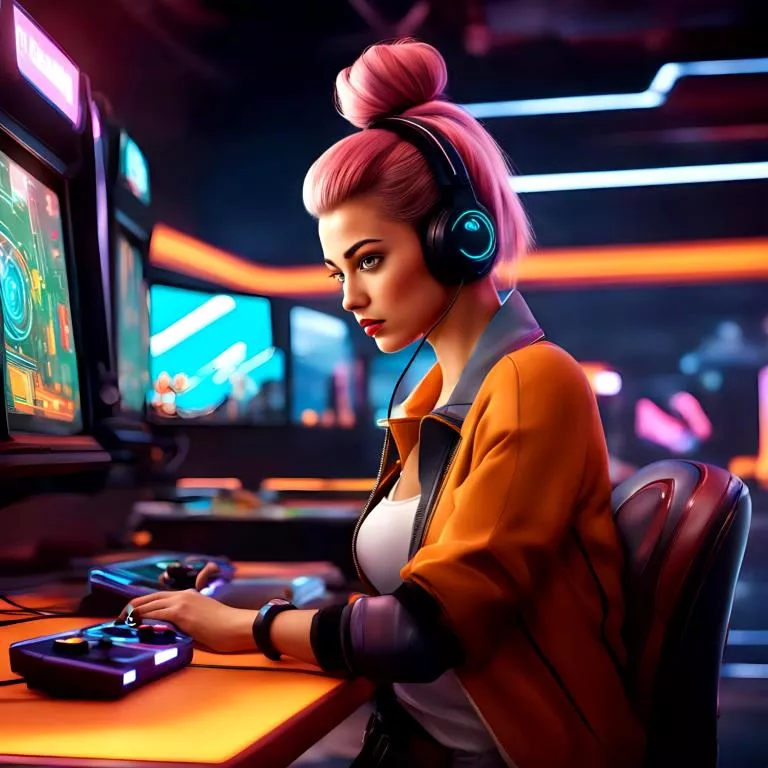Understanding the Game Development Process
The game development process is like baking a cake—minus the flour explosions. It involves a series of steps from idea to execution, where a team of developers, designers, and storytellers work together to create digital masterpieces that make you lose track of time.
The Evolution of Game Development
From pixelated pioneers like Pong to jaw-dropping epics like Cyberpunk 2077, game development has come a long way. With advancements in technology and player expectations skyrocketing, developers have leveled up their game to create immersive experiences that rival blockbuster movies.
Conceptualizing and Planning
Before diving headfirst into game development, developers put on their thinking caps (sometimes literally) to brainstorm ideas that will set players' hearts racing. This phase involves mapping out the game's core elements and identifying the target audience who will be glued to their screens.
Idea Generation and Conceptualization
Game ideas can come from anywhere—be it a late-night caffeine-fueled brainstorming session or a sudden stroke of genius in the shower. Developers jot down these lightbulb moments and flesh them out into concepts that will form the backbone of the game.
Market Research and Target Audience Analysis
Just like Tinder dates, games need to know their audience. Developers conduct market research to understand player preferences, trends, and competitors. By gathering insights on what makes gamers tick, they can tailor their game to provide an experience players will keep coming back to.

Game Design and Story Development
Game design is where the real magic happens—imagine Hogwarts but with more pixels and fewer owls. Designers craft the gameplay mechanics and build worlds that players can immerse themselves in, while storytellers weave narratives that keep players on the edge of their seats.
Creating Game Mechanics and Gameplay
Game mechanics are the unsung heroes of gameplay—they dictate how players interact with the game world. From jumping over obstacles to vanquishing enemies with epic combos, developers fine-tune these mechanics to ensure a smooth and engaging experience for players.
Developing Engaging Storylines and Characters
Just like a gripping Netflix series, games need compelling storylines and memorable characters to keep players hooked. Developers carefully craft narratives that blend seamlessly with gameplay, creating emotional connections that make players laugh, cry, and occasionally rage-quit.
Art and Asset Creation
Artists and designers sprinkle their creative magic to bring game worlds to life—no wands required. From concept art that sets the visual tone to 3D models that give characters depth, this phase transforms sketches and ideas into eye-catching assets that make players go, "Wow."
Concept Art and Visual Style
Concept art is the blueprint of a game's visual identity—a sneak peek into the fantastical worlds players will explore. Artists sketch out characters, environments, and props, setting the visual style that will make the game stand out like a neon unicorn in a field of regular horses.
3D Modeling and Animation
Ever wondered how characters go from flat sketches to fully-realized 3D beings with personality? That's the magic of 3D modeling and animation. Artists meticulously craft digital sculptures and bring them to life with movements that make characters as lifelike as your favorite couch potato.
Programming and Development
So, you want to create a video game? Strap in for a wild ride of coding, debugging, and probably even a few tears. In this phase, developers bring their game concepts to life through the magic of coding and scripting. They make sure all the characters move, the explosions explode, and the dragons... well, they better breathe fire like they mean it.
Coding and Scripting
Coding and scripting are kind of like the secret sauce behind every great game. It's where the developers work their coding mojo to make the game actually work. Think of it as the behind-the-scenes wizardry that makes your game universe tick. From defining player controls to creating enemy AI, this is where the real techie magic happens.

Integration of Art and Design Elements
Now, we can't have a video game without some fancy art and design, right? This is where artists and designers jump into the mix to make things look pretty. From crafting jaw-dropping landscapes to designing epic weapons, they sprinkle that visual magic that brings the game world to life. It's like creating a masterpiece on your computer screen.
Testing and Quality Assurance
Alpha, beta, gamma – no, we're not in a science class. We're talking about testing a video game before it launches into the wild unknown. Once the game is coded and designed, it's time to squash those bugs like you're on a mission. Let's dive into the fun world of testing and quality assurance.
Alpha and Beta Testing
Alpha and beta testing are like the game's trial runs. Alpha testing is when the game is still a bit rough around the edges, and beta testing is when things get serious. Players get to smash buttons, blow stuff up, and report all the glitches they find. It's like being a game detective hunting down pesky bugs before they ruin the fun.
Bug Fixing and Optimization
Nobody likes a buggy game – it's like serving soup with a fork. Once the testers have had their fun finding all the game hiccups, it's time for developers to roll up their sleeves and squash those bugs. Optimization is the name of the game here, making sure the game runs smoothly on any device. It's a bit like fine-tuning a sports car for that ultimate gaming experience.
Launch and Marketing Strategies
You've coded, designed, and tested your game to perfection – now it's time to shout it from the rooftops. Launching a game isn't just about hitting the play button; it's a whole circus of preparation and marketing magic. Get ready to dazzle the gaming world with your masterpiece.
Preparing for Launch
Launching a game is like hosting a grand party – you want everything to be perfect. Developers gear up for the big day by polishing the game, setting up servers, and making sure everything is in tip-top shape. It's like sending your kid off to their first day of school, but with more caffeine and fewer tears.
Marketing Campaigns and Strategies
In a sea of games, how do you make yours stand out? That's where marketing swoops in like a hero. From social media blitzes to dazzling trailers, developers pull out all the stops to grab players' attention. It's like shouting, "Look at me! I'm the coolest game in town!" – but with more finesse and fewer megaphones.
Post-Launch Support and Updates
You've launched your game, but the journey doesn't end there. Keeping players happy and engaged requires ongoing love and attention. Get ready for a rollercoaster of user feedback, community engagement, and post-launch updates that'll keep your game fresh and exciting.
User Feedback and Community Engagement
Players are the heart and soul of a game, so listening to their feedback is key. Whether it's fixing a wonky mechanic or adding a fluffy unicorn skin, developers dive into the player community to keep the game evolving. It's like having a direct line to your gaming fan club – except with way more cat memes.
Post-Launch Updates and DLCs
Just like a garden needs tending, a game needs constant nurturing. Developers sprinkle in updates and DLCs (Downloadable Content) to keep players hooked and coming back for more. It's like adding sprinkles to an ice cream cone – extra toppings that make the game even tastier. So, keep those updates rolling and watch your game grow into a player favorite.In conclusion, the process of creating video games encompasses a complex and multifaceted journey involving creativity, technical expertise, and relentless dedication. From the initial conceptualization to the final launch and beyond, game development is a dynamic and evolving field that continues to push boundaries and captivate audiences worldwide. Embracing innovation, collaboration, and a passion for storytelling, game developers shape immersive worlds and interactive experiences that leave a lasting impact on players. As the gaming industry continues to thrive and evolve, understanding the intricacies of game development provides a deeper appreciation for the art and science behind bringing virtual worlds to life.
